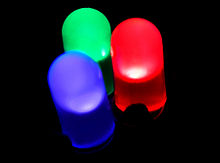History of Computers - LEDs
by Joshua Tsai
Introduction
LEDs are two-lead semiconductor light sources. LED stands for light emitting diode. Today, they can often be seen lighting stuff up.
Significance
Today, LEDs are almost universal due to their lower energy costs, cooler temperatures, and longer durability. Over time, their technology has significantly advanced to make them more universal and in all the colors we see today. [1] LEDs are frequently used for lighting things up, or due to their rapid switching capability, advanced communications. Below is a picture of the Audi A4 LED headlights.


Overview
LEDs are often very energy efficient and can have very different amounts of light released: from small buttons to ceiling lights. LEDs also control the direction their light is released and only release wanted light spectrums. Finally, LEDs are very durable and can last up to 60,000 hours compared to 1,000 hours for similar incandescent light bulbs. For all this, they cost half the price for those 60 light bulbs and require less maintenance costs. LEDs are also less fragile than glass lightbulbs. [2] Also LEDs can control their wavelengths let out, making them useful for certain applications such as growing plants, allowing us to save money by not creating unnecessary wavelengths. In growing applications, LEDs also will release the same amount of light throughout their lives and will not decrease in actual wattage like T5s. [3] Electroluminescence was first observed in 1907 by the Englishman Henry Joseph Round. Round discovered that inorganic materials can glow after a current is passed through and published this on "Electric World." [4] The first visible LED was created in 1962 by Holonyak. After 5 years of work, he was the first to use a visible semiconductor alloy laser to light up the first LED. However, LEDs were first discovered in 1961 by Biard and Pittman for Texas Instruments. They accidentally while attempting to create a X-band GaAs varactor diode. According to Edisontechcenter.org, "The discovery was made during a test of a tunnel diode using a zinc diffused area of a GaAs (Gallium Arsenide) semi-insulating substrate." in Dallas, Texas.[5] However, LEDs are unreliable outside because semiconductors fail at wide swings of temperature and require large heat sinks because they are sensitive to heat.They are also a lot more expensive than other lighting. [6] Read more about semiconductors.
How it Works
A diode is an electron rich material seperated by electron deficient materials, forming a junction. When recieving electrical current, the electrons will jump and later fall back down when the electrical pulse stops and release photons in energy. Depending on the chemical composition of the semiconductor layers, the spectrum of light released will be different, allowing for very focused light spectrums that do not create uneeded or unwanted spectrums of light. [7]

References
https://en.wikipedia.org/wiki/Light-emitting_diode
- ↑ http://www.gelighting.com/LightingWeb/emea/news-and-media/press-room/press-releases/2012/holonyak.jsp
- ↑ http://www.redbeacon.com/hg/pros-and-cons-led-lighting/
- ↑ http://www.hoveyelectric.com/hovey-electric-power-blog/bid/73754/T5-vs-T8-vs-LED-The-Best-Options-For-Replacing-Aging-T-12-Fixtures
- ↑ http://www.osram.com/osram_com/news-and-knowledge/led-home/professional-knowledge/led-basics/led-history/index.jsp
- ↑ http://edisontechcenter.org/LED.html
- ↑ http://www.richmond.com/business/article_74e3e036-37b0-57af-a564-057a63f56fb0.html
- ↑ http://www3.nd.edu/~leds/how/How.htm